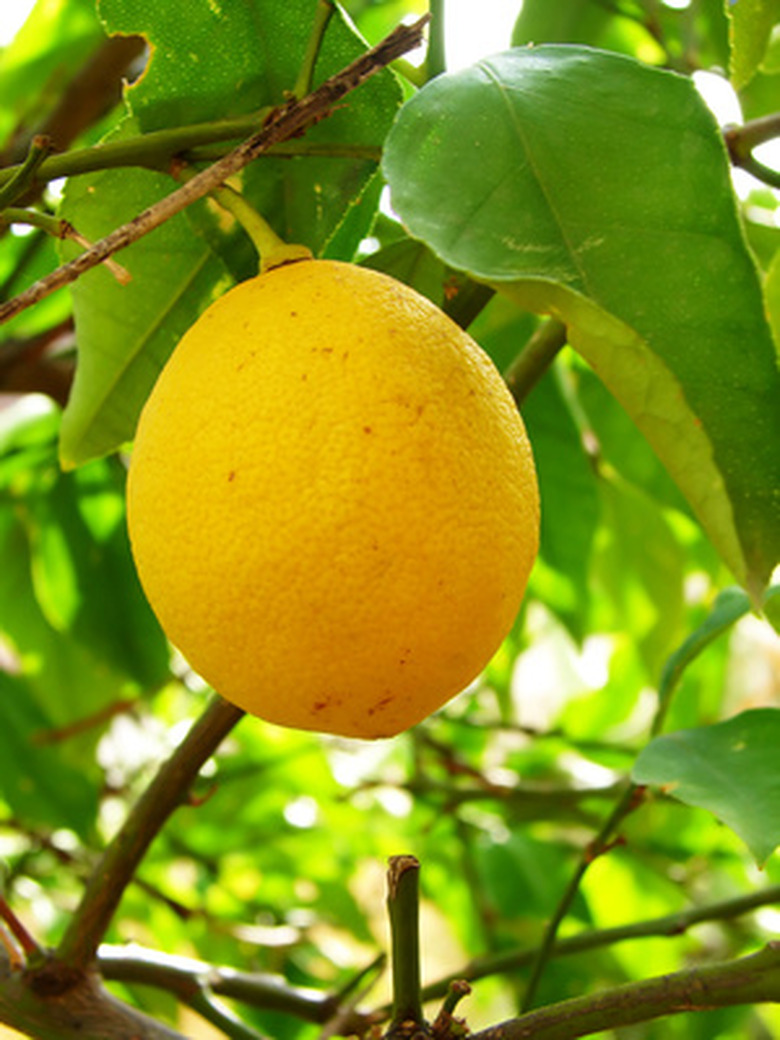Parts Of The Lemon Tree
Of all the citrus trees, lemons (Citrus limon) need the lowest heat requirement to develop good fruit–and may be grown in many more regions than oranges or grapefruit–though lemon trees will suffer damage below 20 degrees F. Lemon trees bear fruit in hot- and mild-summer regions, including the South, Southwest and West. Depending on variety, lemon trees may grow to 20 feet, but whatever the height, all trees have the same basic structure.
Rootstock
The rootstock is the bottom few inches of the tree trunk and the underground root system. If a tree is grafted, the rootstock may be of one variety, while the scion is of another. The two are joined at an area called the "bud union."
Scion
The upper part of the tree, the scion is where the branches form and, ultimately, fruit grows. This area is comprised of a main trunk, from which individual branches grow. Lemon branches are thorny .The scion of a full-grown lemon tree will be full and may be pruned to a desired shape, such as round.
- Of all the citrus trees, lemons (Citrus limon) need the lowest heat requirement to develop good fruit–and may be grown in many more regions than oranges or grapefruit–though lemon trees will suffer damage below 20 degrees F. Lemon trees bear fruit in hot- and mild-summer regions, including the South, Southwest and West.
- Lemon branches are thorny .The scion of a full-grown lemon tree will be full and may be pruned to a desired shape, such as round.
Foliage
Foliage on a lemon tree is evergreen and glossy. The leaves, which are oblong and up to 4 1/2 inches long, are a lighter green than those found on orange trees, but are red when they first appear. The leaves grow on alternating sides of each branch.
Flowers/Fruit
Blossoms on lemon trees begin as small, light red buds, about the size of a pea. These buds open into small blooms that are white on the top and light purple on the bottom. The cup-shaped blossoms have many stamens in the center. The flowers are mildly fragrant and about 1 inch around. After flowers drop their petals, fruit begins to grow, and may take 6 months or more to ripen.
- Foliage on a lemon tree is evergreen and glossy.
- The leaves, which are oblong and up to 4 1/2 inches long, are a lighter green than those found on orange trees, but are red when they first appear.
Lemon Tree
A poor growing location causes the gradual decline of a healthy young lemon tree. These citrus trees grow well in poor soil and even tolerate sandy or clay soil. One of the most important soil properties is good drainage. Look for damaged leaves and fruits as well as insects. For localized infestations, use a strong spray of water to knock the pests out of the tree. Temperatures down to 20 degrees Fahrenheit kill flowers, fruit, leaves and wood. Use a lightweight soil mixture when planting, and feed the tree monthly with a high-nitrogen fertilizer. The best location is within 6 feet of a sunny window and away from heat sources, which dry the soil out too quickly.
- A poor growing location causes the gradual decline of a healthy young lemon tree.
- The best location is within 6 feet of a sunny window and away from heat sources, which dry the soil out too quickly.
References
- Purdue Horticulture: Lemon
- "Sunset National Garden Book": by the editors of Sunset Publishing and Sunset Magazine; 1997
- Cal Poly Urban Forest Ecosystems Institute: Lemon
- Purdue University: Lemon
- Sunset: How to Choose and Grow Citrus
